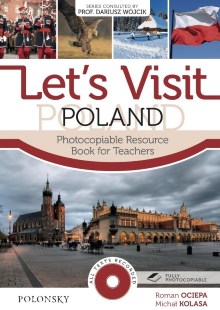Let’s Visit Poland. A Photocopiable Resource Book for Teachers. A Review
Aneta Wilemska-Rudnik, Poland
Aneta Wilemska-Rudnik is a lecturer at Wydział Zamiejscowy Nauk Humanistycznych i Społecznych w Mysłowicach Akademii Ignatianum w Krakowie. She holds PhD in linguistics and a Certificate in English Language Teaching to Adults (CELTA). She is particularly interested in the use of authentic materials, literature and culture in teaching English as well as games and e-learning. E-mail: aneta.wilemska-rudnik@ignatianum.edu.pl

Let’s Visit Poland is an excellent resource book by Roman Ociepa and Michał Kolasa, which is suited exceedingly well to photocopying. It is written with the aim to encourage readers to pick up key information about Poland. The book provides 15 clear, step-by-step units that present various aspects of Poland, including basic information about the country, geography, history, symbols and cuisine. Furthermore, the book draws attention to famous Poles as well as places worth visiting, and the authors have helpfully included interesting chapters on Polish customs, traditions and even myths and legends, making it a well-researched contribution to the topic. By providing a comprehensive picture of the target culture, the book is ideal for Polish and foreign students because it attempts to teach culture by offering a number of preparatory activities with clear goals, making learning more effective. Yet, the book is not only limited to the classroom environment. It can also be read as a travel brochure and be freely used by businessmen traveling round Poland, as an excellent reference source, or by participants of eTwinning or AIESEC programs.
The book can also be used by Poles travelling to foreign countries who are willing to share information about Poland, yet frequently lack the right expressions to discuss diverse aspects of their country. Regarding the educational purpose, each chapter follows the same structure, beginning with a concise lead-in exercise with the aim to kindle students’ interest of the content of the chapter. It constitutes a successful type of activity because by working in pairs students share their existing knowledge and common sense to provide answers to questions. Consequently, they are able to process the text more effectively. Students then proceed to the text which can be used to practice the receptive skill of reading or listening. To prepare students beforehand for the receptive skill assignment, the authors pre-teach key vocabulary which might hinder proper understanding of the text. Then, following the framework of the receptive skill lesson, students are required to answer true/false comprehension questions. The right answers can be given by the teacher, or alternatively students can quiz their partner before the teacher nominates for feedback. This keeps the interest high and students involved. The next set of exercises focuses on the development of vocabulary such as word-building and collocations which have proved successful even with low-level learners. Additionally, everything is connected with the topic of the chapter and actively engage students in the target culture and language.
Some other interesting activities involve practical tasks. The first one involves personalization: under given headings students are supposed to work in pairs or groups and talk about their country. Through such personalizing activities students can gain better cultural understanding. Another interesting exercise is the one which includes retelling the text introduced earlier in the chapter. Words are provided, yet students need to make necessary changes to form meaningful and grammatically correct sentences. This simple technique proves useful for learning both culture and language because it enables student to check what they have learnt and thus improves their language skills. There are also some follow-up tasks which aim at checking what students managed to remember from the chapter. It is, lastly, very easy to extend most tasks into open-ended discussions. All in all, the myriad possible activities presented in this book are what makes it an essential purchase.



|